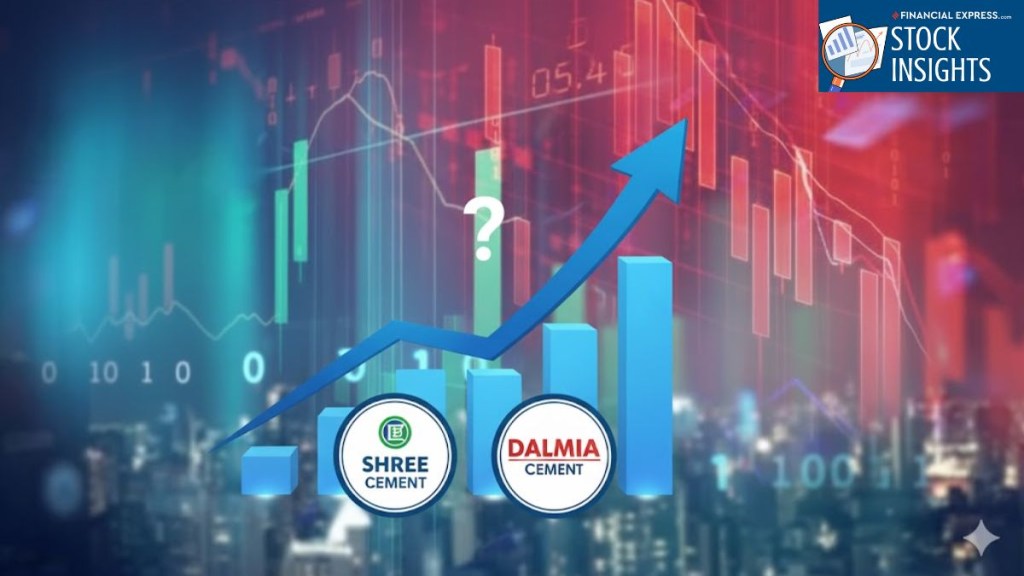Cement stocks have been in the spotlight with the government reducing the GST on this key input for the construction sector to 18% from the earlier 28% from September 22, 2025. In addition, the RBI has taken measures to lower interest rates and boost lending across the broader banking system, and this in turn is also expected to boost demand for cement in the current peak construction season.
It’s no surprise that Dalmia Bharat at Rs 2,134 in intra-day Wednesday trade is not too far from its 52-week high of Rs 2,495 that was reached on 17 September 2025. Shree Cement had gained 2% in early Wednesday trading at Rs 29,188 and it had reached its 52-week high of Rs 32,508 on 22 July 2025.
Beating the monsoon blues: Pricing power shines in Q2
Shree Cement had declared its results after the close of Tuesday trade. The company’s standalone net sales rose 15.5 % y-o-y to Rs 4,303.2 crore in the September 2025 quarter.
The Rajasthan-based company sold 8.1 million tonnes of cement in the September 2025 quarter vis-a-vis 7.6 million tonnes a year earlier, and its realisations grew nearly 8.3 % y-o-y to Rs 5,312 per tonne in the second quarter of FY26. Shree Cement’s key markets are northern region, eastern region and central India.
The monsoon season is typically a slack season for construction activity and demand is sluggish — commendable for Shree Cement to improve realisations in the September 2025 quarter.
Its key power and fuel costs fell nearly 2.5% y-o-y to Rs 1,282 per tonne in the September 2025 quarter, with the company increasingly using its in-house renewable energy supplies. The company has highlighted that its green power capacity was 592.4 MW at the end of the September 2025 quarter and it met nearly 63% of its power requirements in the quarter under review.
As a result, Shree Cement’s operating profit margin rose 330 basis points y-o-y to 19.8 % in the September 2025 quarter. Its standalone net profit at Rs 277.1 crore in the September 2025 quarter rose nearly 197.8 % on a y-o-y basis.
Meanwhile, New Delhi-based Dalmia Bharat’s consolidated revenue from operations grew 10.7% y-o-y to Rs 3,417 crore in the September 2025 quarter.
Dalmia Bharat sold 6.9 million tonnes in the September 2025 quarter vis-a-vis 6.7 million tonnes a year earlier. Its realisations were Rs 4,952 per tonne in the second quarter of FY 26, a rise of nearly 7.5 % on a y-o-y basis. Key markets for Dalmia Bharat are south, eastern and western regions.
And investors cheered Dalmia Bharat improving its realisations in the September 2025 quarter.
Its core operating profit margin rose 770 basis points y-o-y to 19.1% in the September 2025 quarter, helped by higher realisations and they helped offset higher input costs. For instance, the key power and fuel costs, Dalmia Bharat in its investor presentation has highlighted they were Rs 1,017 per tonne in the September 2025 quarter vis-a-vis Rs 1,012 per tonne a year earlier.
Dalmia Bharat’s net profit of Rs 239 crore in the September 2025 quarter, jumped nearly 387.8 % on a y-o-y basis.
Efficiency check: Who makes more from capital?
Screener has highlighted Shree Cement’s return on capital employed (ROCE) of 6.7 % in the current financial year vis-a-vis Dalmia Bharat’s ROCE of 5.58%.
Building for the boom: Expansion pipeline heats up
The peak construction season is currently underway in most parts of the country with the completion of the monsoon season. And the GST on cement has been reduced to 18% from the earlier 28% and lower taxes are expected to boost demand for cement.
In addition, the RBI has taken several steps to boost lending in the broader banking system, and that should give a boost to construction activity and demand for cement in the peak construction season in most parts of the country.
Shree Cement during the September 2025 quarter had commissioned clinker line of 3.65 million tonnes capacity at its integrated project plant at Jaitaran, Rajasthan. Clinker is a key ingredient for cement production. The cement mill of three million tonnes at this site is also expected to be commissioned shortly.
Also, the work on the integrated project at Kodla, Karnataka of three million tonne cement capacity is in final stages of completion. Once these capacities are brought on stream, Shree Cement’s total cement production capacity will reach nearly 68.8 million tonnes.
Meanwhile, Dalmia Cement has also commenced trial production for clinker at Umrangso, Assam for 3.6 million tonnes and commercial production is expected in the third quarter of FY26. Clinker is a key ingredient for cement production – Dalmia Bharat’s clinker capacity was 23.5 million tonnes at the end of FY25 and that is expected to reach 27.1 million tonnes at the end of FY26, according to the company’s presentation.
The company’s current cement capacity is 49.5 million tonnes broadly similar to the levels at the end of the June 2025 quarter, and it is expected to reach 55.5 million tonnes by FY27.
Valuation verdict: Is the growth already baked in?
Shree Cement trades at a P/E of more than 50 times estimated standalone FY26 earnings while Dalmia Bharat trades at more than 35 times estimated consolidated FY26 earnings.
Clearly, cement stocks have factored in the growth opportunities over the next few quarters.
Amriteshwar Mathur is a financial journalist with over 20 years of experience.
The writer and his family have no shareholding in any of the stocks mentioned in the article.
Disclaimer: The website managers, its employee(s), and contributors/writers/authors of articles have or may have an outstanding buy or sell position or holding in the securities, options on securities or other related investments of issuers and/or companies discussed therein. The content of the articles and the interpretation of data are solely the personal views of the contributors/ writers/authors. Investors must make their own investment decisions based on their specific objectives, resources and only after consulting such independent advisors as may be necessary.

